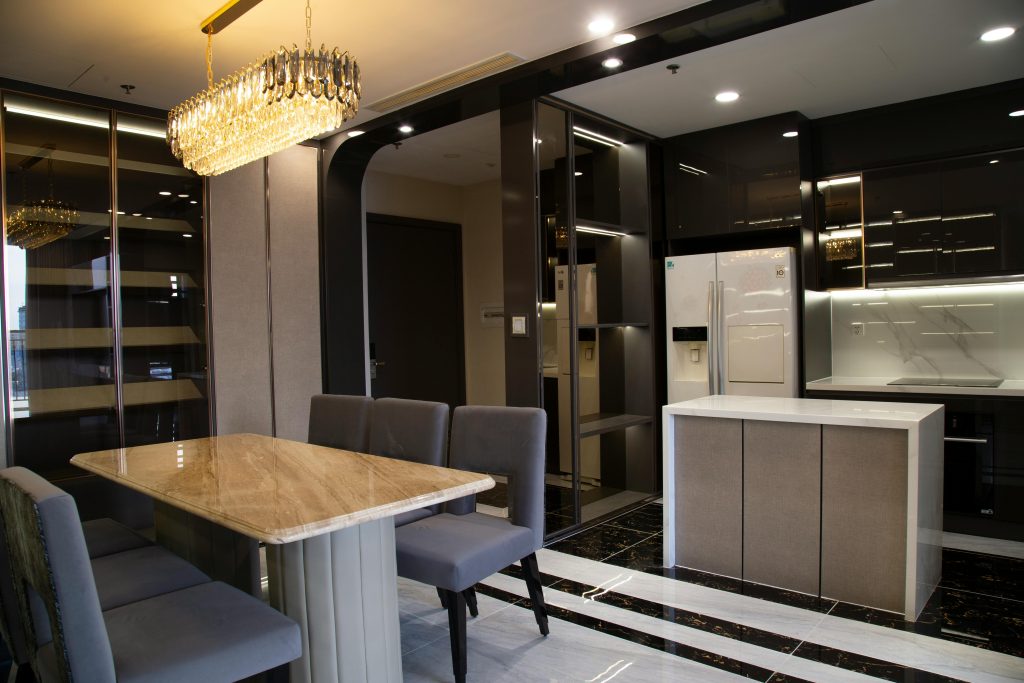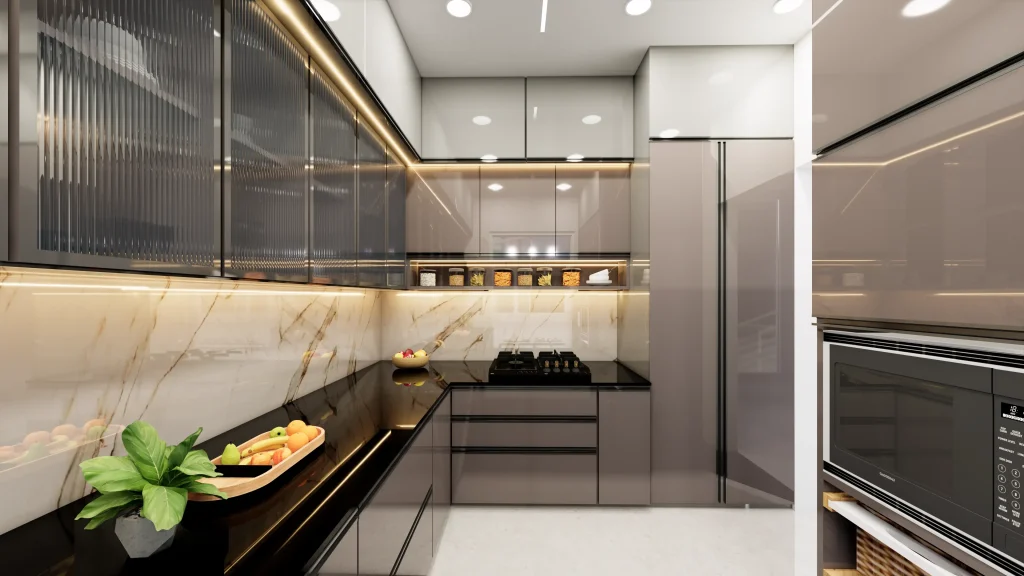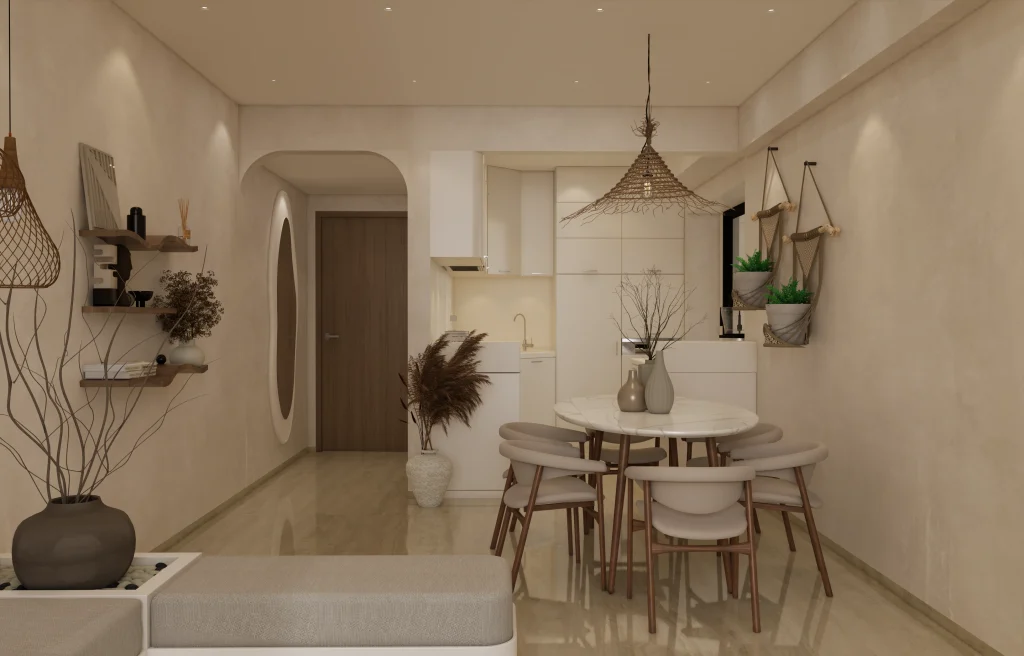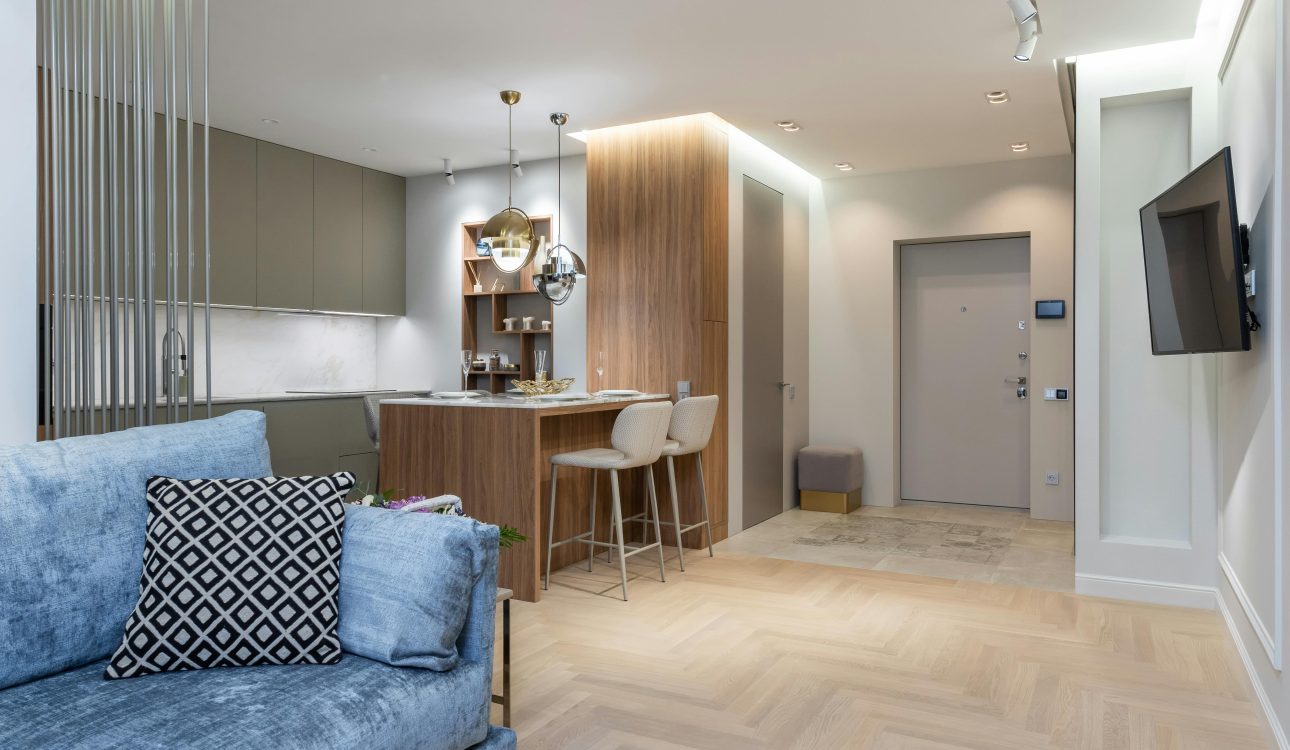Luxury in a Mumbai home is not about excess — it’s about smart decisions, flawless finishes, and a sense of calm that arrives the moment you walk through the door. This guide — written step-by-step and tuned for residential makeovers — walks you through a full luxury interior design process for a Mumbai house: from the first conversation to the final reveal. Every section is practical, house-focused, and arranged as clear steps you can follow, replicate, or hand to a contractor or designer.
If you’re a homeowner, a renovator, or someone planning a full home makeover, this is a playbook: detailed instructions, priorities for materials and systems that suit a coastal, humid climate, and actionable checklists for each stage. Treat each numbered item like a milestone. Done right, the result is a home that reads as modern, layered, and distinctly yours — with luxury that feels earned, not loud.
Discovery — set the intention (Step-by-step)
- Define lifestyle priorities (3–5 concrete items).
- List daily routines: waking, cooking, working from home, entertaining, sleeping patterns.
- Identify must-haves (example: large dining area, walk-in closet, home office) and absolute no-gos (example: avoid dark hallways).
- Rank priorities as A (non-negotiable), B (important), C (nice-to-have).
- Establish aesthetic direction (choose 2–3 descriptive words).
- Pick simple anchors like “contemporary warm,” “modern classic,” or “tropical minimal” to prevent scope creep.
- Collect 8–12 reference images that reflect the chosen words; prioritize interiors with similar volumes/layouts to your house.
- Room-by-room needs an audit.
- For each room, write 6–10 bullet points: primary function, occupancy, storage needs, natural light quality, privacy needs, desired mood.
- Note technical constraints: load-bearing walls, existing ducting, or low ceiling zones.
- Create a project brief document.
- Include budget range (band), timeline expectation, delivery expectations (design only vs design + execution), decision makers, and contacts.
- Add a clause for revisits: “Design will include two rounds of revisions per major space.”
- Snapshot of existing condition.
- Take 20–30 photos: every wall, ceiling, cornice, window, outlet, and service duct. Label them by room and orientation (e.g., Master Bed — north wall).
- Make a short video walkthrough, narrating problem areas and what you like.
Site survey & measurement (Step-by-step)
- Accurate measured drawing (existing).
- Measure each room: length, width, ceiling height, window sill height, door positions, and recesses in mm/cm precision.
- Note service risers, columns, and false-ceiling zones.
- Confirm structural constraints.
- Identify load-bearing walls, beams, and columns. Photograph structural junctions.
- Mark fixed elements that cannot be moved (main electrical panel, sewer stack).
- Utility mapping.
- Record locations of electrical points, water inlets/outlets, AC / HVAC ducts, and plumbing risers.
- Create a simple schematic of these services for rapid reference.
- Light and sun study.
- Note orientation (north/south/east/west) and windows’ solar exposure.
- Capture time-of-day photos for morning, noon, and evening (if possible).
- Final measured plan.
- Produce a clean floor plan with dimensions, door swings, and fixed furniture footprints.
- Get this plan digitally (CAD or high-resolution PDF) to avoid measurement mistakes during procurement.

Concept development & mood boards (Step-by-step)
- Synthesize brief into a concept statement (one paragraph).
- Example: “A calm, contemporary Mumbai home that balances cool stone textures with warm timber, optimized for natural ventilation and layered lighting.”
- Create 3 concept directions (A/B/C).
- Each direction: one line summary, 6 images, color swatches, and 3 proposed materials (floor, wall, accent).
- Present these to decision-makers and get ranked.
- Moodboard to specification mapping.
- For the chosen concept, expand the moodboard into materials: flooring type & finish, paint codes (or sample names), wood species, metal finishes.
- Provide tactile samples or links to sample photos for offline review.
- Principled design decisions.
- List 6 core design rules to obey across spaces (e.g., “avoid more than three different wood tones,” “keep ceilings simple,” “use concealed hardware where possible”).
- Approval checkpoint.
- Sign-off on one concept with a list of three items allowed for adjustment during detailed design.
Space planning & layouts For Interior Design (Step-by-step)
- Functional zoning.
- Define public vs private zones and circulation paths. Ensure arrival sequence — door → foyer → living — feels clear and graceful.
- Keep service flow separate: kitchen deliveries, laundry access, and housekeeping paths should not pass through principal living areas.
- Furniture footprint planning.
- Draw furniture footprints to scale for each room. Put a 900–1200 mm clear walk space in main circulation routes.
- For living rooms: ensure sofa-to-TV distance and coffee table clearance. For dining: allow 900–1000 mm behind chairs.
- Sightlines & focal points.
- Prioritize the primary focal point (fireplace, TV wall, city view) and arrange furniture to enhance it.
- Avoid placing TVs opposite large windows without shading provisions.
- Vertical use & storage strategy.
- Plan built-in storage up to soffit heights; allocate 50–60% of bedroom wall space for storage in luxury homes.
- Use attic spaces or full-height wardrobes for off-season storage.
- Circulation and door geometry.
- Replace inward-swinging doors with sliding or pocket doors where space is tight.
- Consider floor-level transitions and rugs to subtly guide movement.
Materials & finishes — selection and specs (Step-by-step)
- Flooring hierarchy.
- Public areas: choose large-format porcelain or natural stone (marble/granite) with honed or matte finish for durability.
- Private areas (bedrooms): engineered timber or premium laminate for warmth.
- Wet zones: anti-slip porcelain tiles with proper gradient and waterproofing.
- The wall finishes.
- Primary walls: premium washable emulsion (matte) in neutral tones.
- Feature walls: textured finishes like Venetian plaster, engineered stone veneer, or vertical wood slats.
- High-moisture walls: ceramic tile or waterproof paints.
- Ceiling treatments.
- Keep main ceilings simple with concealed lighting covers for a luxury interior design feel.
- Use false ceilings for service concealment but avoid overuse — preserve height where possible.
- Joinery & cabinetry finishes.
- Specify marine-grade plywood or MR plywood with laminate/veneer finishes in kitchens and wardrobes.
- Use solid wood edges on visible parts; soft-close mechanisms for drawers and doors.
- Metals & hardware.
- Choose a limited palette (two metal finishes max): brushed brass for accents, matte nickel for hardware.
- Locksets, hinges, and plumbing finishes should match in finish and grade.
- Sample testing.
- Order 300×300 mm samples and test on-site under actual light. Check for color shifts at different times of day.
- Create a physical finish board for approvals.
Color Combination & lighting strategy (Step-by-step)
- Establish base, middle, and accent colors.
- Base: neutral foundation (warm white, soft beige).
- Middle: supporting tone for wood and stone.
- Accent: one or two richer tones used sparingly (deep green, navy, terracotta).
- Lighting layers — plan three layers per room.
- Ambient lighting: concealed LED coves, recessed downlights with dimming control.
- Task lighting: reading lamps, under-cabinet lights, pendant lights over dining or kitchen islands.
- Accent lighting: wall washers, picture lights, LED strips in coves or shelving.
- Lux levels and control.
- Specify lux levels: living room ambient 150–200 lux, kitchen counter 300–500 lux, master vanity 400–600 lux.
- Use multi-zone dimming and CCT (correlated color temperature) control for warm-to-neutral daylight shifts.
- Natural light enhancement.
- Maximize daylight with sheer curtains and reflective surfaces; position mirrors thoughtfully across windows.
- Use window treatments for privacy + light control: layered blinds plus sheer curtains.
- Lighting fixtures selection.
- Choose statement pendants or chandeliers for arrival and dining zones to anchor spaces.
- Keep downlights small and well spaced (spacing = 1.5 × ceiling height rule for even coverage).
Furniture selection & layout For Interior Design (Step-by-step)
- Define furniture language.
- Decide scale (low & expansive vs tall & compact) and stick to a maximum of three distinct furniture styles to maintain coherence.
- Custom vs modular.
- Use custom joinery for fitted needs (TV units, wardrobes). Choose modular for sofas and occasional pieces to ease future changes.
- For luxury finish: prioritize custom for kitchen island and storage integrated with appliances.
- Ergonomics and comfort.
- Validate sofa depth, seat height, and mattress specs in person. Luxury is comfort plus craft.
- For dining, ensure table height 750–760 mm; chair seat height ~450 mm.
- Material & upholstery choices.
- Use high-durability fabrics (tightly woven blends) for high-traffic areas; silk/velvet for bedroom accent pieces.
- For Mumbai humidity, prefer breathable fabrics and quick-dry cushions.
- Placement & circulation verification.
- Walk the layout physically using tape on the floor to confirm flow. Adjust accordingly.
- Keep at least 450 mm from sofa backs to walls where possible, or allow 900–1200 mm for major circulation.
- Sourcing plan.
- Make a furniture sourcing schedule: order lead times, delivery windows, and assembly plan. Factor 6–12 week lead times for custom pieces.
Kitchen & utility design (Step-by-step)
- Work triangle and workflow.
- Plan sink, hob, and refrigerator in a functional triangle; ensure unobstructed prep spaces near hob and sink.
- Countertop & storage decisions.
- Use durable countertops (engineered quartz or granite) for longevity; waterfall island edges for a luxury touch.
- Deep drawers for pots, pull-out trays for spices, and tall pantry units with internal organizers.
- Appliances and integration.
- Specify built-in appliances for a seamless look: hob with chimney, integrated fridge, and dishwasher hidden behind panels.
- Plan for 20–25% extra power circuits for kitchen appliances.
- Ventilation & wet-proofing.
- Ensure high-CFM chimney/hood in Mumbai kitchens for humidity and cooking smell control.
- Install water-proofing in the utility and kitchen slab areas and a floor drain in utility areas.
- Lighting & materials.
- Under-cabinet lighting across the entire run; pendant lights above island for a focal element.
- Use easy-to-clean splashbacks: glass, engineered stone, or large-format tiles.
- Service zones and housekeeping.
- Provide dedicated laundry and housekeeping storage near the kitchen with appropriate exhaust ventilation.

Bathrooms & wet areas (Step-by-step)
- Waterproofing and drainage.
- Install three-layer waterproofing with an independent balcony/wet area gradient. Test for 72 hours before tiling.
- Specify anti-slip tiles (R11 equivalent) and grade the floor towards the drain.
- Fixtures & fittings specification.
- Select premium-grade concealed tanks, wall-hung WCs, and thermostatic showers for luxury performance.
- Use hand showers + overhead rain where space allows.
- Vanity & mirror planning.
- Floating vanities create a sense of space; specify solid surface or engineered stone countertops.
- Plan heated mirror options or demisters in humid climates.
- Lighting & ventilation.
- Combine LED ceiling flush mounts and task lighting beside mirrors, ensuring CRI >90 for makeup and grooming.
- Provide exhaust fans sized for bathroom volume or connect to a common exhaust riser.
- Storage & access.
- Include recessed medicine cabinets and niches in shower zones for toiletries.
- Consider a towel warmer if desired for a luxury feel.
Storage strategies & wardrobes (Step-by-step)
- Audit belongings.
- Count clothes, luggage, seasonal items, and equipment. Translate into linear meters of wardrobe needed (rule of thumb: 1 adult = 0.8–1.2 linear meters).
- Zoning inside wardrobes.
- Allocate zones: long hanging (dresses/coats), short hanging (shirts), folded shelves, drawers for intimates, shoe racks, and a dedicated accessory organizer.
- Maximize vertical space.
- Use full-height units, overlapping shelves, and lift-up racks for high shelves.
- Use modular inserts and dividers to keep items tidy and visible.
- Invisible storage for luxury.
- Design built-ins that appear as uninterrupted walls with concealed handles and consistent laminate/veneer finishes.
- Housekeeping & utility storage.
- Plan broom closets, cleaning supply cabinets, and hidden ironing boards near laundry.
Smart home Interior Design, MEP & services (Step-by-step)
- Electrical layout & future-proofing.
- Identify smart hubs and a central communication rack; provide spare conduits for future cabling.
- Allocate dedicated circuits for AC, refrigerators, oven, and EV chargers if needed.
- Lighting controls & automation.
- Install multi-zone dimmers, scene controls, and app-based systems for lighting and blinds.
- Consider occupancy sensors for common areas to save energy.
- HVAC & thermal comfort.
- For Mumbai, prioritize efficient split systems or VRF with proper refrigerant piping insulation and drip pan access.
- Provide mechanical ventilation in wet zones and service areas.
- Plumbing planning.
- Use concealed copper PEX lines for longevity; ensure accessible manifolds for individual flats.
- Plan for water purification and pressure booster where necessary.
- Acoustics and insulation.
- Use acoustic underlays for floors and careful sealing around doors for privacy in bedrooms.
- Consider acoustic panels in home cinemas and study rooms.
- Documentation & Handover.
- Maintain an MEP log with labeled panels, valve positions, and service manuals. Provide warranties and service schedules.
Project management & procurement (Step-by-step)
- Create a master schedule.
- Build a Gantt-like timeline listing design phases, approvals, procurement lead times, delivery windows, and installation slots.
- Factor buffer time: 15–20% for custom items and 10–15% for shipment delays.
- Budget banding & contingency.
- Break down costs room-by-room: finishes, MEP, joinery, FF&E (furniture, fixtures & equipment), and labor.
- Keep a 10–15% contingency for luxury projects to preserve quality when surprises arise.
- Procurement strategy.
- Prioritize long-lead items first (custom cabinetry, marble slabs, imported lights).
- Use purchase orders with clear delivery & penalty clauses to maintain schedule.
- Vendor vetting & contracting.
- Choose vendors with verifiable portfolios and one-point warranty contacts.
- Use milestone-based payments linked to deliveries and quality checks.
- Quality checkpoints.
- Set sign-off stages: pre-installation, mid-installation, and final installation checks.
- Use a 20–30 point snagging checklist for finishing items, hardware alignments, paint touch-ups, and grout lines.
- Communication cadence.
- Weekly site meetings with minutes, clear action items, and a shared digital folder for documents and photos.
Execution, site supervision & quality control (Step-by-step)
- Mobilization and site setup.
- Designate a tidy contractor zone and labeled material storage. Protect finished floors and surfaces with temporary coverings.
- Trial mock-ups.
- Build a 1:1 mock-up for critical areas (kitchen elevation, bathroom tiling, feature wall) to confirm finishes and tolerances.
- Sequence of works.
- Follow logical sequence: demo → rough MEP → blockwork/partition → services → plaster/skim → flooring → joinery → finishes → FF&E installation → snagging.
- Supervision priorities.
- Check for level and plumb regularly; small errors in early stages balloon into visible defects later.
- Ensure grout lines, tile cuts, and alignment of joinery are consistent across adjacent surfaces.
- Mid-installation audit.
- Conduct a formal mid-point audit to identify rework needs. Update the snag list and adjust schedule if necessary.
- Final snagging & rectification.
- Create a final snag list with photographic evidence and assign clear deadlines for rectification.
Styling, soft finishes & final touch Interior Design (Step-by-step)
- Textiles and layering.
- Layer curtains (sheer + blackout) and use rugs to anchor seating areas. Scale textiles to room size — large rugs make rooms feel bigger.
- Include cushions with varied textures; keep color palette consistent with accents.
- Art and accessory curation.
- Choose 3–5 meaningful art pieces or sculptures for focal walls. Ensure art scale is proportional to the wall.
- Curate accessories as grouped vignettes, not random clutter.
- Greenery and scents.
- Use low-maintenance indoor plants in corners and statement pots by windows. Consider a professional plant-care schedule.
- Subtle ambient scents (diffusers) enhance first impressions — pick neutral woody or citrus notes.
- Final furniture tuning.
- Adjust furniture spacing after items are in place. Keep 400–600 mm between the coffee table and sofa for comfort.
- Soft handover staging.
- Create a ‘first-night’ setup: essentials in the kitchen, a staged bedroom, basic cleaning supplies accessible.
- Professional photography.
- Capture the finished space with natural light and twilight shots for portfolio and to reflect on design choices.
Handover, aftercare & maintenance (Step-by-step)
- Handover packet.
- Provide a well-organized binder or digital folder with warranties, user manuals, finish schedules, maintenance instructions, and contact numbers.
- Demonstration & training.
- Walk the homeowner through systems: lighting scenes, HVAC controls, appliance operation, and warranty registration.
- 30/60/90-day review.
- Schedule follow-up visits at 30, 60, and 90 days to check for settling issues, touch-ups, and any adjustments.
- Seasonal maintenance checklist.
- Provide a list: HVAC servicing before monsoon and summer peaks, grout sealing yearly, reproofing balconies every 3–4 years.
- Long-term replacement plan.
- Note expected lifespan for major items (soft furnishings 5–7 years, kitchen countertops 10–15 years, major appliances 8–12 years) and plan budgets accordingly.
- Contact & escalation path.
- Define the support process for repairs and part replacements, with a named contact for swift resolution.

Practical checklists (Quick references)
Pre-design checklist For Interior Design
- Project brief signed.
- Measured drawings & photos uploaded.
- Priority list finalized (A/B/C).
- The budget band and timeline agreed.
Interior Design approval checklist
- Concept sign-off.
- Finish board approved (samples on site).
- Lighting & electrical layout signed.
- MEP schematic confirmed.
Pre-installation checklist For Interior Design
- Long-lead items ordered.
- Contractor mobilized & site protected.
- Mock-ups completed and approved.
- The waterproofing test passed.
Handover checklist For Interior Design
- Final snagging completed.
- Manuals and warranties handed over.
- System demonstrations done.
- 30/60/90-day follow-ups scheduled.
Conclusion
A luxury home makeover in Mumbai is a meticulous sequence of thoughtful decisions — from the initial brief to the last cushion placed on the sofa. Treat the process like a layered composition: clear function and circulation at the base, refined materials and lighting as the middle layers, and careful styling as the final flourish. The step-by-step approach in this guide is designed to keep decisions focused, quality high, and the end result unmistakably refined.
Remember: luxury Interior Design is not the loudest choice — it’s the quiet confidence of well-executed details. Follow these steps, maintain strong communication with your team, and build in time and contingency for excellent finishes. Your home will not only look stunning; it will work beautifully for the life you lead inside it.

